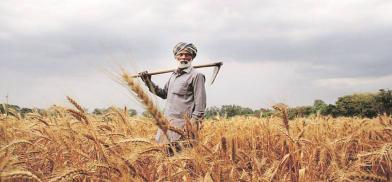Food security in South Asia: India must act as ‘annadata’ for region
As South Asia is now better connected, ensuring BBIN food security will become even easier with packaging centres set up in each country with its own distribution, writes Amb Sarvajit Chakravarti (retd) for South Asia Monitor

India has again banned the export of certain foods to the immediate discomfiture of our closest neighbours, both geographically and politically.
Given India’s open borders with Bhutan and Nepal as well as a porous border with Bangladesh, such actions will only encourage smuggling and retail inflation in those countries and fuel public opprobrium against India.
All these countries are severely nutrition-stressed with nearly 75 percent of the populations, on average, unable to afford the $2.87 required daily to nourish a family of four. With lack of nourishment, we are putting the upcoming generations, upon whose output and enterprise we will all depend for survival as we age and lose our own earning capacities, in very serious jeopardy. The demographic dividend South Asia can enjoy will turn into a very serious disaster.
The time is ripe, therefore, for India to consider these three countries as part of its own food security network and not as foreign countries who may be denied access to food by India at will. Their own food production strengths can complement ours and supply-demand mismatches can be alleviated by such cooperation.
Ensure food
The BBINSM subgroup of SAARC mutually shares SAFTA benefits which are supplemented by bilateral arrangements: so mutual trade in essential foodstuffs should not be a problem. It will rather serve to diversify and strengthen food supply networks and supply chain, reduce fertilizer shortages and subsidies, benefit from sharing best agricultural practices, create output complementarities, reduce demand-supply mismatch, lower bulk import costs and improve distribution across South Asia. As Swami Vivekananda said, "To a hungry person, food is God."
Let us not make food an issue to sour our relations with neighbours. India's "Neighbourhood First" policy provides the imperative and the impetus for all of us to feed and nourish the hungry of our lands first, and the wider world thereafter.
How can this be achieved? First, by agreement on a common standard of nutrition, such as proposed by WHO. Secondly, by analyzing the components of a nutritious meal to estimate what is in short supply where. We could, perhaps exchange wheat with Bangladesh for their rice. Nepal and Bhutan could be growth engine for horticulture, producing temperate fruits and berries that are increasing in global demand as superfoods for micro-nutrition.
Food and trade
Bangladesh and Nepal tea could get their own GI tags to find their proper places in the world market. Fish, eggs, chicken pork and mutton could be delivered to areas in short supply. Since one man's meat is another man's poison, we should not impose sectarian restrictions on food output, processing or supplies. Processing food in simple ways at harvest point to extend its shelf-life will go a long way to reduce post-harvest losses, currently at over 40 percent, and make our supplies adequate for our billions.
Vertical farming, multi-level agriculture, mixed animal husbandry and horticulture, targeted and controlled irrigation, simultaneous multi-cropping at different levels will increase and diversify our regional food output while simple village level preserving techniques will generate biomass based energy, create employment, increase incomes while preserving perishable crops for longer term use by extending shelf-life and preventing spoilage.
Recycling biomass waste into the soil will promote organic farming. Apiary development will aid pollination and produce organic honey while keeping elephants and other crop raiders away. It will also optimize land use and release surplus acreage for other necessary purposes such as afforestation, water harvesting and upgrading of villages to desirable modern levels of facilities and comfort.
Food and more
Agricultural and animal husbandry research and educational institutions in the cooperating countries may do cooperative research, share best practices and access international funding and expertise to improve technical education, input quality, extension services, preservation and marketing capabilities as well as refrigerated distribution and retail capability.
To feed the still-growing population of South Asia, a sharper cooperative focus is needed across the entire research, education, dissemination, input distribution, production support, harvest oprimization, preservation and supply through wholesale and retail sale to the final consumer.
It will generate fresh vigour and dynamism and move our large population based on subsistence and sharecropping agriculture up the value and income chain. This will enable regional GDPs to maintain the 8-10 percent rate of growth necessary for us to achieve developed country targets now being pursued and promote regional solidarity in the process.
Doorstep delivery
The doorstep service delivery programmes of some state governments, including ration, are most welcome steps in giving our citizenry the primacy they deserve and in saving millions of productive man hours spent waiting in queues for collection periodically.
This service of ration delivery can be further enhanced by making hygienic Weekly Family Nutrition Packs based on WHO nutrition recommendations, by private or public packaging companies at the state level in India for last mile delivery by the India Post or other courier agencies. Food delivery in this manner can be targeted particularly towards BPL families. This will also avoid leakage and spoilage of the food.
Since South Asia is now better connected that ever before, ensuring BBIN food security will become even easier with packaging centres set up in each country with its own distribution systems. A pilot project on these lines, if successful, can be scaled up to state, national or even international levels and benefit WFP and other agencies distributing food to people in distress around the planet. It may also enhance service incomes and add to employment generation.
Healthy, happy South Asia
A healthier and properly nourished South Asia will reduce our healthcare burden, improve absorption of education and skills training and development, improve the environment, reduce warming and foster the ambition and drive among our youth to strive for a better quality of life and help propel this geographical area to the heights of prosperity we are all capable of achieving.
But India must take the first small step to be ‘annadata’ ( food provider and benefactions ) to our smaller neighbours and partners when necessary. This will enable our smaller neighbours to produce crops with greater value addition and export value to increase agricultural income across the region.
Surety of supply will avoid duplication of crop acreage and optimize land and resource use. This will improve our rankings in the HDI and help achieve collective the SDGs and MDGs sooner rather than later. Cooperation will lead to trust; confrontation to distrust -- that will be a growing headache for us all.
(The author is a former Indian ambassador who was Deputy High Commissioner in Bangladesh. Views are personal)










Post a Comment